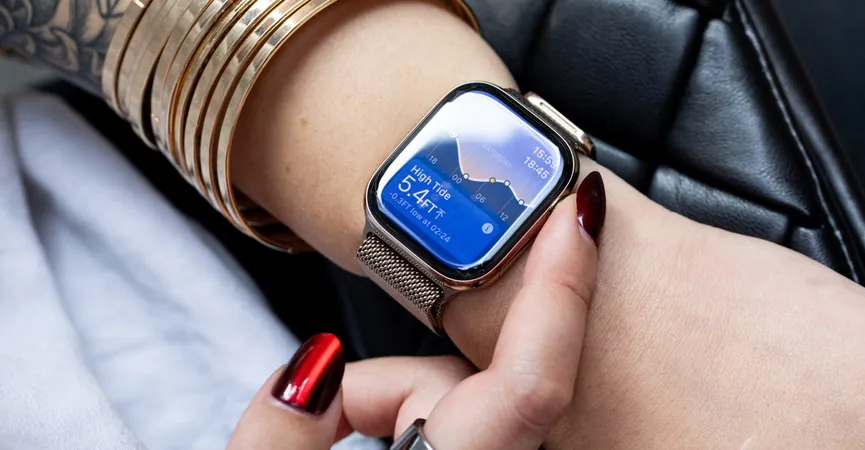
Why Apple's Decision to Open iOS is a Game Changer for Smartwatches!
2025-03-21
Author: Ling
Introduction
The smartwatch market has often been divided into two camps: iOS enthusiasts and Android aficionados. A quick glance at any smartwatch buying guide reveals this division, highlighting recommendations specifically catered to iPhone or Android users. Illustratively, guides often feature sections like “Best Smartwatches for iPhone Owners” or “Top Choices for Android Users.” This separation wasn't always so pronounced. Just five years ago, wrist-wear from brands like Samsung or Fossil could sync with iPhones, but their functionality was limited compared to the Apple Watch.
The Dominance of Apple Watch
The primary advantage of the Apple Watch has always been its seamless integration with the Apple ecosystem, enabling users to send quick replies to texts and easily connect to other Apple devices like Macs and AirPods. For many users, using a third-party smartwatch that lacked these features felt impractical, even if the design or price was more appealing. Dyed-in-the-wool Apple Watch supporters often wondered why potential alternatives failed to offer similar functionalities, and the answer invariably pointed to Apple's restrictive policies.
Changes in the Wearables Landscape
Fast forward to 2021, and the wearables landscape took a notable turn when Android smartwatch makers began pivoting away from iOS compatibility with the introduction of Wear OS 3. As a consequence, consumers watched as platform-agnostic options dwindled, making it challenging for those not wedded to the Apple ecosystem to find appealing smartwatch solutions.
A Landmark Decision by the European Commission
Recently, the European Commission's move to mandate that Apple opens up iOS interoperability presents a silver lining for both smartwatch manufacturers and consumers. This landmark decision means Apple can no longer monopolize features, allowing third-party smartwatch makers to access and interact with iOS notifications. This change is a breath of fresh air for Garmin fans who have long been limited in their ability to send quick replies from their devices.
Apple's Concerns Over Innovation
In reaction to this, Apple has voiced concerns, arguing that such moves could stifle its innovation. Apple spokesperson Marni Goldberg stated that this could compel the company to 'give away new features for free' to competitors who don’t adhere to the same regulations. However, the past few years have seen relatively little evolution in smartwatch technology. Major competitors, like Samsung with its Galaxy Watch lineup and Google with its Pixel Watch, have largely played it safe, taking cues from Apple rather than paving new paths.
The Need for Innovation
With the smartwatch segment stagnating, it's no surprise that interest has shifted to emerging technologies like smart rings and smart glasses. There’s a sense of predictability in the current smartwatch market; if you have an iPhone, an Apple Watch is expected, while Android users gravitate toward options like the Galaxy Watch or Pixel Watch. Endurance athletes might settle on Garmin for its robust training metrics, but outside of these established patterns, there’s little motivation for manufacturers to innovate.
Anticipating the Future of Smartwatches
The stagnation becomes particularly disheartening as we anticipate new releases. With the smartwatch landscape seemingly barren, the excitement reminiscent of the smartwatch boom from 2014 to 2020 feels like a distant memory. Some predict that 2025 smartwatches won’t offer much beyond what is currently available, and many tech enthusiasts are hoping to be proven wrong.
The Power of Open Interoperability
Another shining example of why open interoperability matters is seen in Apple’s Powerbeats Pro 2. While they function seamlessly within Apple’s ecosystem, Android users enjoy broader flexibility in their usage. For instance, on iOS, the heart rate feature is restricted to a handful of apps, whereas Android users can connect to a variety of choices without limitations, highlighting the importance of consumer options and flexibility in technology.
Conclusion
Ultimately, the European Union's decision to enhance interoperability will empower consumers to choose the smartwatch that aligns best with their needs, irrespective of their smartphone brand. For instance, a dedicated marathon runner may prioritize a Garmin for its extensive training features but also desire quick text reply functionality typical of Apple Watches. Admittedly, there’s significant convenience in sticking to one tech ecosystem. Yet if Apple truly lays claim to the title of the 'best' smartwatch, it must be prepared to defend that status amidst an increasingly competitive landscape where third parties can now compete on equal footing.


 Brasil (PT)
Brasil (PT)
 Canada (EN)
Canada (EN)
 Chile (ES)
Chile (ES)
 Česko (CS)
Česko (CS)
 대한민국 (KO)
대한민국 (KO)
 España (ES)
España (ES)
 France (FR)
France (FR)
 Hong Kong (EN)
Hong Kong (EN)
 Italia (IT)
Italia (IT)
 日本 (JA)
日本 (JA)
 Magyarország (HU)
Magyarország (HU)
 Norge (NO)
Norge (NO)
 Polska (PL)
Polska (PL)
 Schweiz (DE)
Schweiz (DE)
 Singapore (EN)
Singapore (EN)
 Sverige (SV)
Sverige (SV)
 Suomi (FI)
Suomi (FI)
 Türkiye (TR)
Türkiye (TR)
 الإمارات العربية المتحدة (AR)
الإمارات العربية المتحدة (AR)